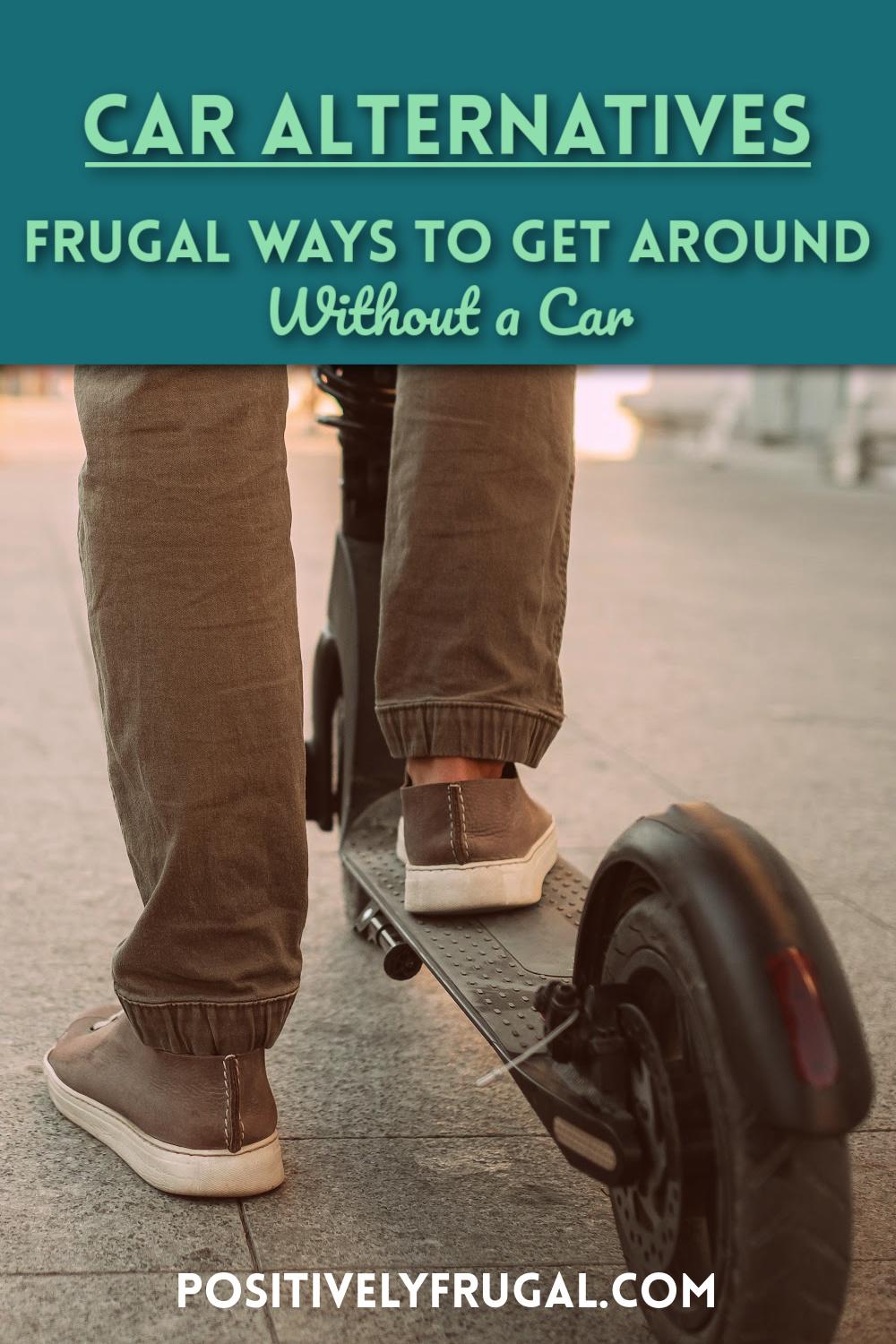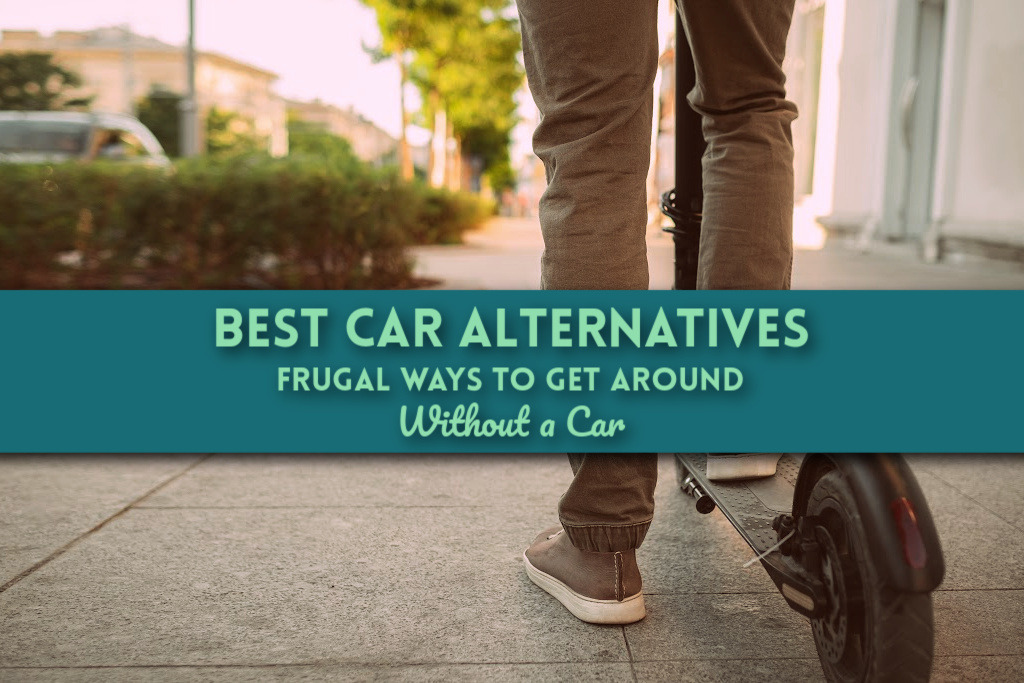Some of the links on this site are Affiliate Links and if you use them to make a purchase, we may earn a commission. For more information, read our Disclosure Policy.
Owning a car can cost a truckload! (Bad pun, I know.) Even if you own your car outright, you still have to pay for insurance, upkeep, maintenance, parking and gasoline. If you are fed up with filling up your gas tank or are paying more for maintenance than your car is worth, then it might be time to seek out car alternatives.
Why Find Car Alternatives?
In a car-addicted society (like the USA is), it can be difficult to fathom giving up your car in favor of alternative ways of transportation. Some might even contend that it is taking frugality to the extreme.
I, too, think it is on the extreme end of frugality. Even though owning a car is costly, it is also easy and convenient. There is a certain freedom in owning a car. On the other hand, not being burdened with the expense of a car and discovering alternatives to car ownership can be equally freeing, at least financially speaking.
In an era when tank of gas can cost close to 50 bucks and car prices are still nearly at their peak, the benefits of driving less are impossible to ignore.
From personal experience, I can vouch that by finding automobile alternatives will save you money. A lot of money. Additionally, finding car alternatives allows you to get out of your comfort zone and tap into your creativity.
That said, I understand, too, that in some cases a car is necessary. Much of America just isn’t built for carless living. While completely giving up your car may be unrealistic, you can find alternatives to driving all the time.
Challenge yourself – if not to give up your car completely, to at least find cheaper transportation on occasion with frugal car alternatives.
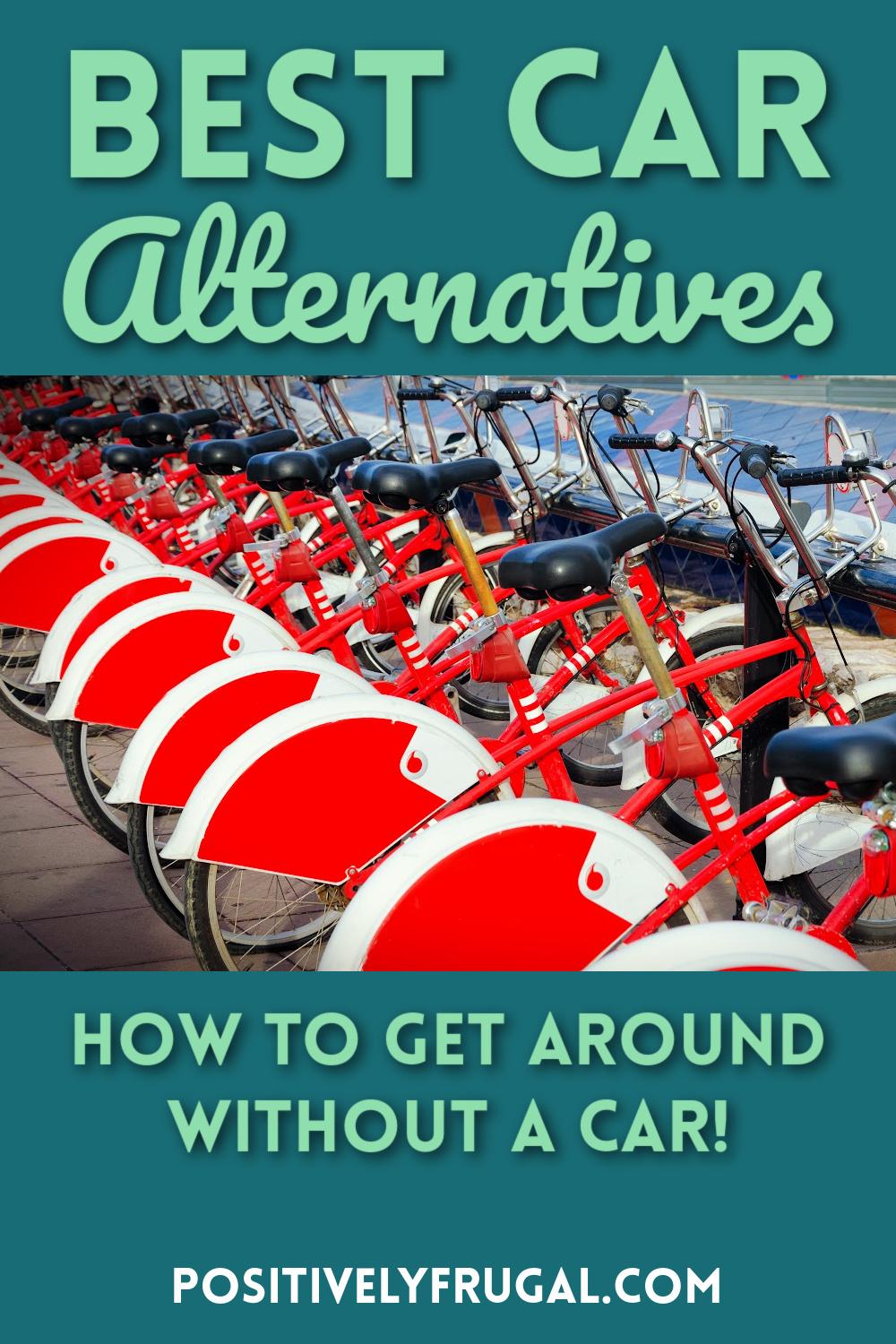
13 Best Alternatives to Cars: How To Get Around Without a Car
You may be wondering, How do you get somewhere without a car? If you live in the United States, it is a valid question. Coming up with alternative car scenarios can be mind boggling. Don’t fret; my list of car alternatives features the best cheap ways of transportation that allow you to leave your car at home…or get rid of it altogether.
#1 Walk
Walking is the cheapest transportation option of all – it’s completely free, with no vehicle required. You don’t need to spend a dime getting from Point A to Point B when using your own two feet (although I do recommend wearing a good pair of shoes!).
That said, while walking is one of the best ways of transportation without a car, it is typically only ideal for short-distance transportation. If you need to cover long stretches, walking may take longer than it is worth. Always remember to factor time into your money-saving calculations.
On the other hand, walking is one of the best forms of exercise. By walking – instead of driving – you might be able to ditch the gym pass (saving you even more money!)
#2 Bicycle
Cycling is another form of cheap transportation and one of the best alternatives to owning a car. With a bike, you can cover distances far more quickly than by walking. Additionally, as many cities aim to be more green, you may find that there is a dedicated bike lane that will allow you to more safely cycle on the road.
For many people, biking is the best way to get around without a car.
However, unlike walking that is completely free of charge, there are some costs associated with using a bike as a form of transit. There is, of course, the initial cost of the bike (if you don’t already own one), plus safety items – like a helmet, light and reflective gear. Bicycles also may require some maintenance, like new tires.
That said, bicycles remain one of the cheap ways to get around without a car – and there are plenty of more ways to save on the necessary equipment.
Rather than splurging for a brand-new bike and accessories, see if you can find cheaper, used gear at thrift stores, bike shops or online platforms, like Craigslist.
#3 Bike Share
I absolutely love community bike share programs as alternatives to driving! If you are fortunate enough to live in a city or town that sponsors a bike share program, it can be a fabulous way to get around for cheap.
How it works is that, instead of buying your own bike, you borrow one for a small fee. Bike Share programs offer cheap forms of transportation – and it’s easy to use, too.
The docking stations are typically self-service. Bikes are unlocked from the station with a membership app or credit card. You are charged for the time you use the bike until you dock it at the station nearest your destination.
#4 Electric Bike
One of the best ways for how to get to places without a car is an E-bike. The benefit of an electric bicycle is that there is a motor that helps propel you, making it easy to get to where you need to be. (This is especially true if you are riding a long distance or need to tackle hills).
There are different types of e-bikes in a range of prices – so you will need to find that one that best suits your needs and your budget. Additionally, in some states, e-bikes are considered a personal transportation vehicle and require registration, so check with your local government if you intend to purchase an e-bike as an alternative to buying a car.
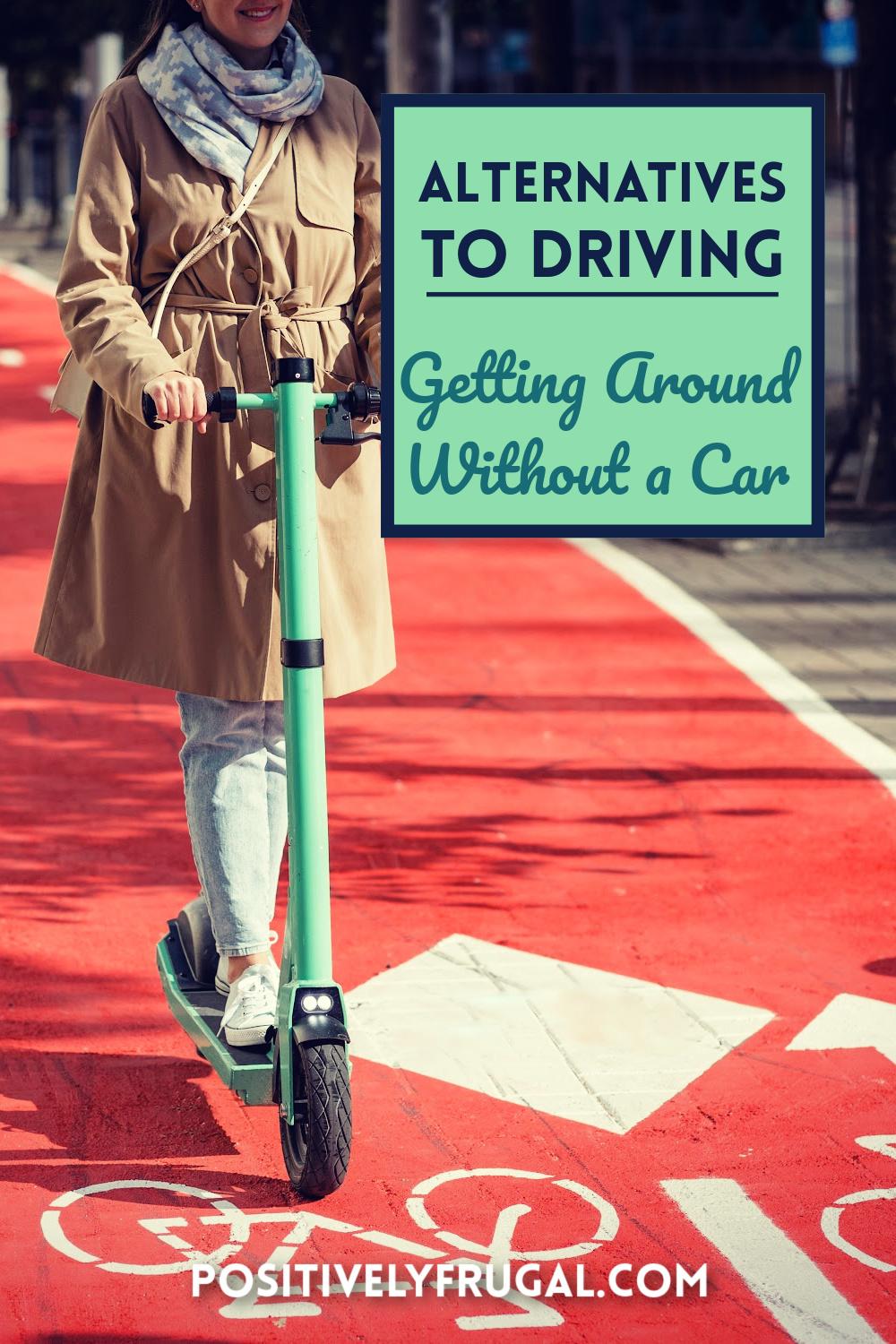
#5 Scooter
Scooters are fantastic cheap car alternatives – and there are two types: Electric and Kick.
Electric scooters are definitely one of the automobile alternatives that can save you money. Usually less expensive than a bicycle, an electric scooter is an affordable option for getting around.
The benefit of a scooter is that it requires zero effort on your part (aside from staying balanced and paying attention to where you are going!). Therefore, if you are carrying items – like food from the grocery store in a backpack, for example – it can be a much more comfortable ride.
Before investing in a scooter, however, be sure to check your local laws concerning requirements – like a helmet, sidewalk use and road rules.
A kick scooter – which is a scooter without a motor – is another cheap transport option. Costing just over $100, kick scooters are great for short work commutes and one of the least expensive car ownership alternatives.
#6 Carpool
One of the best ways to start driving less – and start saving more – is by carpooling. In most parts of America, it is simply a reality that you need vehicular transportation – often to get to your job, but also to the store, pharmacy, doctor’s office or any other place.
Buddying up with a friend to carpool is an excellent way to limit how often you use your car. Not only does it save money on gasoline, but you will also save on other car costs, like the wear-and-tear of your vehicle.
Carpooling is even better if your route includes a highway with a carpool-only designated lane – so while you are saving money, you will also save time!
#7 Public Transport
Public transportation has long been the answer for anyone questioning how to get somewhere without a car. In fact, it can be the best cheap transportation option in many cases.
Most major cities in the US at least offer bus services, while some big cities boast numerous forms of public transit, like trains, subway lines and light rail services.
In the last city I lived in, I was fortunate to live just a couple blocks from a light rail station. My husband used the service for his daily work commute – and although it wasn’t an option for my job, I frequently used the light rail as an alternative to my car on weekends.
Suburban Public Transit
The problem many Americans run into when it comes to using public transportation as a car alternative is that service is infrequent or altogether non-existent. This is especially true for suburban dwellers. Sure, in New York City and San Francisco, travel by public transit is easy…but in places like Arlington, Texas public transit is lacking at best.
So, how can you get to work without a car using public transit if you live in the suburbs? Check to see if there is a convenient Park and Ride. While you will still need a car to get to the Park and Ride point, you can still save gas money – and heaps of stress – by only driving a portion of your route. Better yet, see if someone in your neighborhood wants to carpool to the Park and Ride!

#8 Rental Car
If you are on the verge of going car-free but are worried about the few times a year when you really need a car to get somewhere, then consider using car rentals as a mode of transport.
Although car rentals can be pricey, they can be used as an alternative to owning your own car if you only need a car a couple weeks a year, then renting a car just for those days, weekends or weeks would likely be much cheaper than owning a car and driving it regularly.
One bit of advice: Before you sell your car with the intention of using a rental to fill the gaps, be sure to price out the cost of a car rental in advance. You can find some tips on how to find cheap car rentals here.
#9 Car Sharing
Car sharing is a relatively new concept, but one that can be incredibly cost efficient! While similar to renting a car, how car sharing programs work is that you basically rent a car from a private owner or company for a short drive (typically less than 1 day).
For carless drivers, a pay-as-you-go car sharing program is fantastic – especially for when you need a car for just a few hours. For instance, if you only really need a car to run certain errands or to visit family or friends that live further afield, then car sharing is a top choice.
Turo is a top-rated peer-to-peer car sharing program that is available in most US cities. With Turo, there are no membership fees and per hour fees are as low as 4 dollars. The best part is that Turo drops the car off where you need it and picks it up when you are done.
Zipcar is company that owns a fleet of vehicles that can be rented by members by the minute, hour or day. Because of the time flexibility, Zipcar is one of the cheap transportation options for people who need a car to drive somewhere, but don’t own a car.
#10 Ride Share
Ride sharing is another ingenious way to get around for cheap. Basically, riders post a request for a ride to a certain destination – typically from city-to-city – and if someone is already heading that way, the driver will pick up passengers to join them for the journey for a fairly nominal fee. The ride might even be shared with other travelers.
Ride sharing is an excellent option for college students, who want to make the trip from campus to their hometown for a weekend visit.
I have used the BlaBlaCar ride sharing service in Europe – and found that it was a cheap, easy and convenient mode of transit. Unfortunately, BlaBlaCar has not yet made it to the States, but Canadian-based Poparide is said to be launching in the USA soon.
Note: Via was one of the best ride sharing services in the United States, but they have sadly switched gears from a ride sharing platform to a public transit software company (which, in the end, might help your city develop a better and more efficient public transportation plan!).
#11 Uber or Lyft
Uber and Lyft are another form of ride sharing, but more like a taxi service than catching a ride with someone who is already making the trip.
What I love about Uber and Lyft is that it is so insanely simple. After downloading the app, you create and account and enter your credit card information. Then, whenever you need a ride, you simply request a car. The app allows you to choose what type of car – and it shows you exactly the price you will pay before you even request the ride.
Just be aware, while both of these car services are less than paying for a taxi, they are still pretty expensive. And, if you get caught out during a price surge (on a weekend night, holiday or during an event), the cost for even a short ride can be astronomical.
#12 Barter with Family and Friends
If you do decide to forego owning a car, you can still catch free rides or borrow a car from friends and family. In order to stay in their good graces – and not push your luck as a freeloader – find something that you can barter.
Offering assistance on their home projects or whipping up something for them from your kitchen are two good places to start.
#13 Get Delivery
The world has changed; as it stands today, almost anything can be delivered to your doorstep. In fact, with everything that can be delivered to your home – from groceries to medications to clothes – it is actually more realistic than ever to give up your car.
Looking at your bottom line, you may actually find that medications are cheaper when you have them delivered. You may find that you save on your grocery bill by using a delivery service. Furthermore, if you use delivery in place of owning a car, upgraded services – like Amazon Prime that offer free delivery – will quickly pay for themselves. You can get a Free 30-Day Amazon Prime Trial to see if the savings would add up for you!
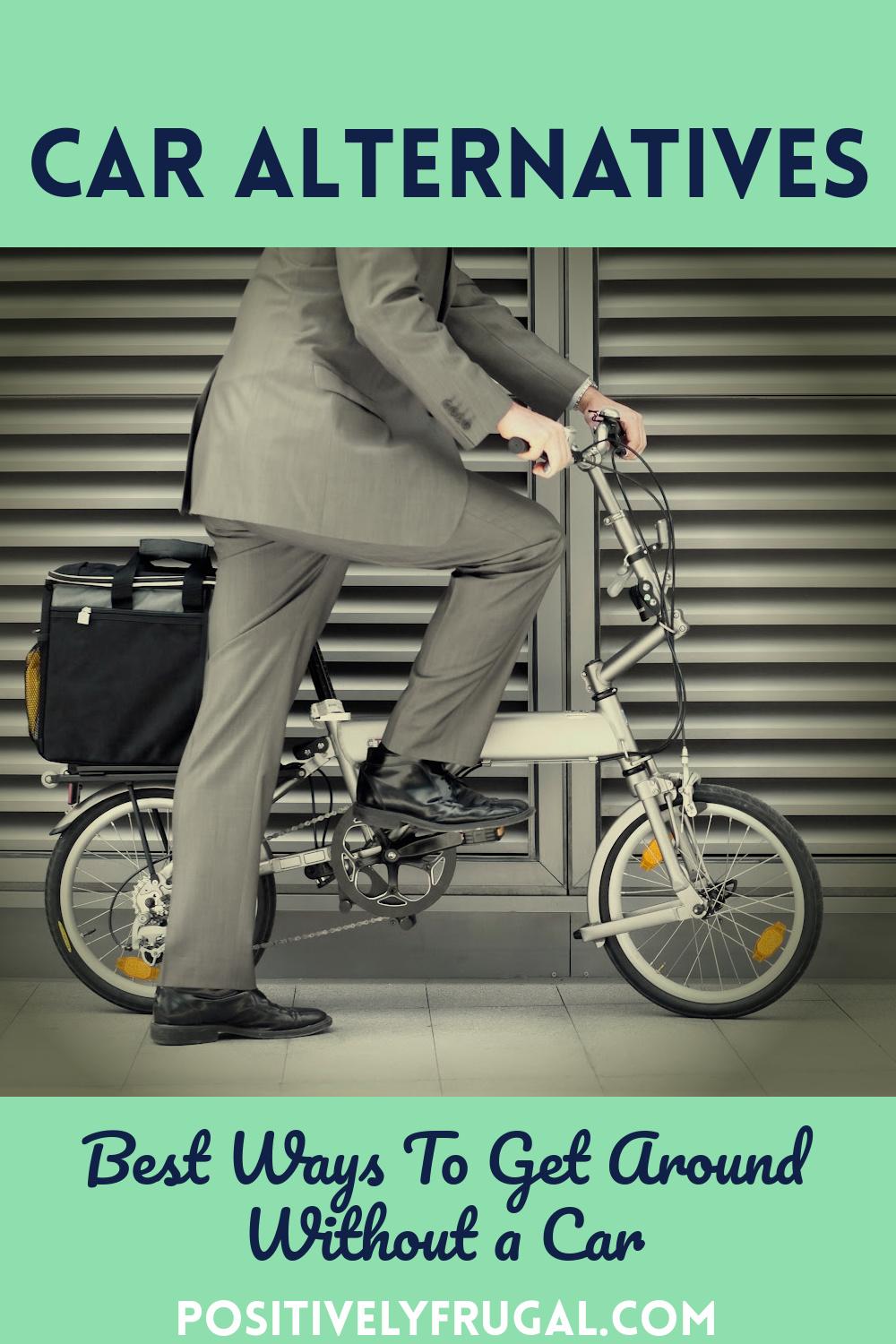
Top Tips for Cheap Alternatives to a Car
Now that you know a few of the best ways to get around without a car, I have a few more tips to share on the subject.
Make Your Budget
Before committing to a completely car-free lifestyle, review your budget. You need to know your money numbers as it relates to car ownership. Find the exact figure of how much you spend on owning a car for a year, month, week and day. Average out the price of gas, the cost of insurance and the fees associated with maintenance, upkeep and registration.
Without knowing how much money you will save, you don’t know if giving up your car is worth it.
If you do determine that it benefits your budget to get rid of your car, be sure to Track Your Savings!
Inquire about Working from Home
Most people have to drive to and from work. In fact, getting to a place of employment is one of the biggest reasons to own a car. If you could instead work from home – and not have to make the drive between your house and the office – you could save heaps of money.
Find out from your company if working from home is an option – even if you only do it a few times a week. If your presence is required at the office, ask about working longer shifts for fewer days. Many companies allow their employees to work 4 10-hour days a week, which means one less day a week of driving your work commute.
Become a One Car Family
If you are looking for ways to reduce your family finances, yet another way to reduce your car expenses is for couples to share one car, rather than each owning one.
It does take a little finesse to work out the details and get into the groove of owning just one car as a couple, but the reduction in expenses can be substantial!
Start Small
It’s tough to flip the switch from being a car owner to living car-free. Rather than going all in, consider starting small.
Before selling your car, attempt a few of the best car alternatives on a trial basis. Try walking to the grocery store when you only have a few items to buy. Bike to your friend’s house, instead of driving. Commit to taking public transport to work one day a week. Attempt a completely carless weekend.
Test the waters of not driving all the time and you might find out that it’s easier than you thought.
Examples of Why Alternatives to Driving a Car are Beneficial
Not yet convinced that giving up your car – or at least giving it a bit of a break – is a good idea? I’ve already mentioned the health benefits, but I have a few more examples of just how beneficial it can be to use alternative modes of transportation!
Limits Your Shopping to What’s on Your List
By walking – or scootering – to the grocery store, instead of driving a car, shoppers need to carry home what they buy. Rather than giving in to impulse buys and filling your cart with things you don’t need, it forces you to stay focused on your shopping list and what you can physically carry home.
Stop Shopping Out of Boredom
How many times have you steered our car into the Target parking lot out of boredom? Each time, undoubtedly, spending money you didn’t intend to spend? Without a car, however, you are much less likely to go boredom shopping. (And, by the way, if you struggle from over-shopping, use my tips for How to Stop Spending Money.)
Make New Habits
Getting out from behind the wheel will likely push you slightly out of your comfort zone – and that is the perfect place to start making new frugal habits. Instead of doing what you always do – driving – you can come up with new ideas for fun (and cheap) hobbies and try new free activities.
Set Up a Sinking Fund
No doubt, when you start driving less, you will start saving more. Don’t let those funds disappear into the rotating abyss of our bank account. Instead, intentionally save the money you would typically spend on your car in a Sinking Fund.
There are many different types of Sinking Funds – so you can decide if you want to put the money saved toward something useful (like getting out of debt!) or something fun (like a vacation!).
We Want To Know: What car alternatives have you tried? What are your frugal living tips for going completely car free? Tell us in the comments!
Interested in more of my Life and Entertainment Tips? I round them all up on the Frugal Lifestyle page!
